| Diese Seite auf Deutsch! |
|
Terrestrial SnailsGastropoda Cuvier, 1795 |
|
 |
||||||||||||||||||||||||||||||||
| Number of species in Mollusca, displayed by classes, including percentage. Sources: WoRMS: MolluscaBase eds. (2025): Mollusca LINNAEUS, 1758. | |||||||||||||||||||||||||||||||||
 Herald thorn snail (Carychium minimum): Arcata, California, USA. Photo: Alex Bairstow (iNaturalist). |
How did this astonishing richness in gastropod species happen? The basis is that snails and slugs, apart from mussels and clams (Bivalvia) are the only sub-group of molluscs that contains species not only living in the sea, but also in freshwater. And among all molluscs, gastropods are the only ones to successfully colonize dry land.
In contrast to the relatively uniform habitats of the oceans, terrestrial environments are far more diverse and varied. The many adaptations that enabled snails to colonise almost all terrestrial habitats led to an explosion of species diversity, which explains why there are far more species of snails than of any other molluscs on Earth.
 Western heath snail (Helicella itala): Asturias, Spain. Photo: Miguel A. Casado (iNaturalist). |
To survive outside the water, snails had to develop a number of special adaptations. Like other molluscs, they do not possess a tough, resistant outer skin, and so dry land turned out to be their greatest enemy: land snails are almost constantly threatened by desiccation. Most species are protected by their solid calcareous shell and by their mucus layer. In addition, many land snails rest during dry periods and become active mainly at night and in the early morning, when the risk of evaporation is lower.
Surprisingly, however, there are also snail groups that are xerophilous (heat- and drought-loving), such as the heath snails (Geomitridae, see photo). In other groups the shell has been reduced, either partially for greater mobility (semi-slugs) or completely (slugs).
|
 Helicina unizonata (Helicinidae): Orellana, Ecuador. Photo: Stephen Luk (iNaturalist). |
 Round mouthed snail (Pomatias elegans): Asturias, Spain. Photo: Gilberto Sánchez Jardón (iNaturalist). |
||
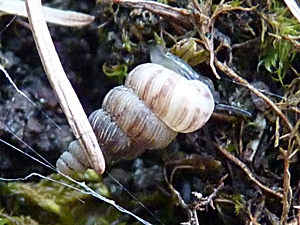 Cochlostoma septemspirale from the Salzburg Hills, Austria. Photo: Martina Eleveld. |
 Dentate thorn snail (Carychium tridentatum): St. Gallen Pro- vince, Switzerland. Photo: © Stefan Haller. |
![]() MolluscaBase eds.
(2025):
Prosobranchia Milne-Edwards,
1848:
Notes.
MolluscaBase eds.
(2025):
Prosobranchia Milne-Edwards,
1848:
Notes.
Research during the past decades, however, has shown that these groups are no more closely related to each other than they are to groups outside the Prosobranchia. Consequently, modern systematics has rearranged them into separate subclasses.
![]() Additional
Information on Gastropod
Systematics.
Additional
Information on Gastropod
Systematics.
Among the Neritimorpha are the marine and freshwater nerites (Neritidae), represented for example by the freshwater nerite Theodoxus fluviatilis. Alongside these aquatic nerites there are also terrestrial relatives in the family Helicinidae. These are assumed to have evolved from amphibious ancestors that lived in mangrove swamps or similar brackish-water habitats.
![]() Marine Gastropods:
Neritimorpha.
Marine Gastropods:
Neritimorpha.
In contrast, the highly diverse group of the Caenogastropoda comprises about 35% of the estimated snail species on Earth. Within this group, several evolutionary pathways appear to have led to the colonisation of land:
In the order Architaenioglossa, which includes the freshwater mud snails (Viviparidae) and apple snails (Ampullariidae), the superfamily Cyclophoroidea evolved: This group includes the terrestrial Aciculidae and Cochlostomatidae. This suggests that these lineages may have developed from freshwater-dwelling ancestors.
In the order Littorinimorpha are found the shore-dwelling periwinkles (Littorinidae), as well as many other well-known marine snails. Terrestrial representatives of this order are the round mouthed snails (Pomatiidae). Even today, they often can be found close to the seashore, sometimes even in the splash zone. This indicates that terrestrial snails may have developed from coastal marine ancestors similar to the periwinkles.
![]() Marine Gastropods:
Caenogastropoda.
Marine Gastropods:
Caenogastropoda.
 Mouse ear snail (Myosotella myosotis): Bouches-du-Rhône, France. Photo: Daniel Pavon (iNaturalist). |
 Cylindrical rock snail (Cylindrus obtusus): Schneeberg, Lower Austria. Photo: Martina Eleveld. |
Among the Pulmonates, the order Ellobiida includes amphibious coastal snails (Ellobiidae, e.g. the mouse ear snail Myosotella myosotis) as well as the terrestrial thorn snails (Carychiidae).
![]() Weichtier des Jahres 2008: Mäuseöhrchen - Mysotella myosotis (Draparnaud,
1801) (in German).
Weichtier des Jahres 2008: Mäuseöhrchen - Mysotella myosotis (Draparnaud,
1801) (in German).![]() Coast Snails (Ellobioidea).
Coast Snails (Ellobioidea).
Another important order within this group are the terrestrial pulmonate snails (Stylommatophora). This order comprises by far the majority of terrestrial snail species, including most of the land snails that are familiar in everyday life. Their most obvious feature is the presence of two pairs of tentacles, unlike in other snails, with the larger upper pair each carrying an eye at their tip.
Unlike the operculate land snails, the Stylommatophora are hermaphrodites, possessing both male and female organs within a single genital apparatus. Hermaphroditism also offers a clear reproductive advantage: in regions or periods with low population density, every encounter between two individuals can result in successful mating.
Another adaptation to terrestrial life is their mode of development. While marine snails typically pass through free-swimming or planktonic larval stages, land snails develop entirely within the egg. The hatchlings emerge as fully formed miniature snails that already resemble the adults in all major features.
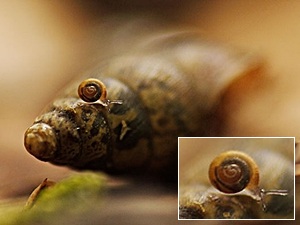 Dot snail (Punctum pygmaeum) compared to a mountain bulin snail (Ena montana), from Switzerland. Photo: © Stefan Haller, (schneckenfoto.ch). |
Note: With the exception of the largely marine or amphibious coastal snails, Pulmonates are not truly marine snails, but for the sake of completeness they are nevertheless listed on the corresponding page.
![]() How did snails conquer the land?
How did snails conquer the land?
The Stylommatophora include extremely small species such as the
dot snail (Punctum pygmaeum, see photo),
with a shell diameter of only 1.6 mm, and giants such as the
Giant African snail (Achatina achatina),
with its shell size reaching up to 20 cm in length. In total, almost 23,000
species of land snails are currently recognised (as of 2024). The origin of the
group is assumed to date back to the Cretaceous period (![]() Geological Time
Periods).
Geological Time
Periods).
Which adaptations enabled gastropods to live on dry land?
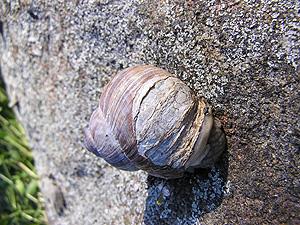 Roman snail (Helix pomatia) with a damaged, and later repai- red, shell. Photo: Robert Nordsieck. |
 Garden banded snail (Cepaea hortensis) during aestivation. Photo: Robert Nordsieck. |
|
 "Hopping" Cornu aspersum (cf. Text). Photo: Robert Nordsieck. |
The mantle, the layer of tissue that lines the visceral sac and the shell aperture, has the additional task of secreting calcium for shell growth, which the snail absorbs with its food. This allows the shell to grow with the animal until it reaches maturity, and also enables the snail to repair damage to its shell.
While operculate land snails can close the shell aperture with their shell lid (Operculum), the terrestrial pulmonates (Stylommatophora) lack this possibility. Many of them survive dry periods either buried in the soil or attached to a surface. During this estivating phase they seal the shell aperture with a thin membrane of dried mucus.
![]() Aestivation in Roman Snails (Helix pomatia).
Aestivation in Roman Snails (Helix pomatia).
A special case are the door snails (Clausiliidae). Their name derives from the clausilium, a unique closing apparatus consisting of a movable plate and several lamellae within the aperture and final whorls. Unlike the operculum, which is attached to the tail end of the foot, the clausilium is connected to the columella and closes the aperture when the snail withdraws into its shell.
 Common door snail (Alinda biplicata): Lambrecht, Rhineland- Palatinate, Germany. Photo: Matthias Buck (iNaturalist). |
 Final whorls of Alinda biplicata, laid open. The shell spire (Co- lumella), as well as the Clausilium, are visible. Photo: Mathijs Zonneveld (iNaturalist). |
Another very important protection against desiccation is the mucus covering the snail's entire body and is left behind as a trail when the snail crawls. Snail mucus is hygroscopic: instead of losing water, it binds moisture - a property that is particularly noticeable in many slugs, whose sticky slime is difficult to wash off. This protects the animal from drying out.
Snails can produce different types of mucus, which not only protects them from predators but also facilitates locomotion on various surfaces. Thanks to their pedal mucus, snails can even move unharmed across sharp-edged substrates.
Some species from warmer habitats, such as the brown garden snail (Cornu aspersum), move during drier weather by touching the ground with only parts of the sole. This reduces water loss and is referred to as "hopping locomotion".
![]() Snails:
Locomotion.
Snails:
Locomotion.
Dryness and solar radiation are major factors influencing the distribution of land snails. This can be clearly seen in the door snails (Clausiliidae), which have achieved a great diversity on the southern Balkan Peninsula. In Greece and neighbouring countries, for example, the genus Albinaria is widespread with many species. Their populations are often isolated from one another, leading to allopatric speciation.
![]() MolluscaBase eds.
(2025):
Albinaria Vest, 1867.
MolluscaBase eds.
(2025):
Albinaria Vest, 1867.
 Eastern heath snail (Xerolenta obvia): Puławy, Poland. Photo: Ewa Rauner-Bułczyńska (iNaturalist). |
 Common roundback slug (Arion vulgaris) opening the pneumostome and thus showing a view into the pulmonal cavity. Video: Martina Eleveld. |
In terrestrial pulmonates (Stylommatophora), the mantle cavity or lung is closed by the pneumostome, which the snail can open and close to regulate breathing. In this way, water loss through evaporation from the respiratory cavity is minimised.
The operculate land snails, on the other hand, do not possess such a breathing pore. In their case, air flows directly into the mantle cavity, where oxygen is absorbed. When the snail withdraws into its shell and seals the aperture with the operculum, it reduces its oxygen consumption as much as possible. However, the operculum does not close the aperture completely airtight.
![]() Operculate land snails:
Secondary Air Respiration.
Operculate land snails:
Secondary Air Respiration.
With the exception of some freshwater
species, pulmonates, like most other gastropods, use haemocyanin as a
respiratory pigment. This molecule is based on copper rather than iron, which
gives the blood of a snail a bluish colour when oxygenated.
![]() Snails:
Respiration.
Snails:
Respiration.
 Eye stalk of a Roman snail. Photo: Martina Eleveld. |
The upper pair also functions as tactile organs but primarily serves as eye stalks, providing the snail with a much wider field of vision. Land pulmonates have the most highly developed eyes among snails, equipped with a simple lens. However, these are hardly comparable to the eyes of vertebrates, since they only provide a blurred image of the surroundings. For this reason, it is crucial that land snails can withdraw their tentacles by muscular contraction when they touch an obstacle, whereas blood must be pumped into them in order to extend them.
![]() YouTube channel
of molluscs.at:
Roman
snail (Helix pomatia) extending a tentacle.
YouTube channel
of molluscs.at:
Roman
snail (Helix pomatia) extending a tentacle.
 Head of a Rosy wolf snail (Euglandina rosea): Seminole County, Florida, USA. Photo: Jeffrey Gammon (iNaturalist). |
Below the smaller tentacle pair are the lips or labial flaps of the snail. These are equipped with taste cells that help the animal locate and identify food sources. By following the slime trail of another snail, they can also determine whether it belongs to a potential mate or perhaps to a hostile predator.
In Roman snails, the slime trails of conspecifics can even limit mating readiness: if a snail detects that population density is already too high, its willingness to reproduce decreases. A similar crowding effect has also been observed in Giant African snails (Achatinidae).
Predatory land snails, which are more numerous than one might expect, also use their tentacles and lips to locate prey. Carnivorous species that hunt other snails, such as the rosy wolf snail (Euglandina rosea) from Florida and surrounding regions, pursue the slime trails of other snails – even across water and up trees – until they capture their prey. Their common name, "wolf snail", is therefore quite appropriate. The lips of wolf snails are strongly elongated, giving the impression of a third pair of tentacles.
![]() Snails:
Eyes,
Sense organs.
Snails:
Eyes,
Sense organs.
![]() Snails:
Tentacles.
Snails:
Tentacles.
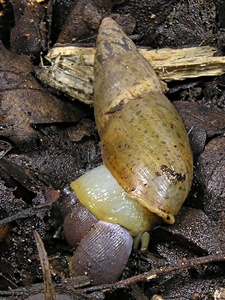 |
 Acid damage of a Poiretia dila- tata on the shell of Pomatias elegans, an operculate land snail. Left: Poiretia dilatata attacking Pomatias elegans. Photos: Fabio Liberto. |
![]() Dalmatian Predator Snail
(Poiretia cornea).
Dalmatian Predator Snail
(Poiretia cornea).
![]() Snails:
Nutrition II.
Snails:
Nutrition II.
For this reason, the composition of the substrate is one of the limiting factors for the distribution of snails. Shell-bearing species are particularly common on calcareous soils, and for several reasons:
Here, snails can obtain calcium directly from their food, and some species even ingest soil particles. Weathering of limestone produces a thin but fertile soil layer which, if sufficient moisture is available, supports rich vegetation. This vegetation in turn provides food, shelter from predators, and protection against solar radiation. However, limestone also has its drawbacks. Mechanically it is very hard, but at the same time highly permeable to water. As a result, limestone regions can be quite dry, and in extreme cases karst landscapes may develop. This, too, can limit the distribution of snails.
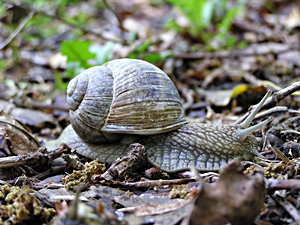 Die Schalenhaut (Periostracum) dieser Weinbergschnecke ist durch Umweltverschmutzung stark in Mitleidenschaft gezogen. Bild: Robert Nordsieck. |
![]() Snails:
Shell.
Snails:
Shell.
In contrast to many of their marine relatives, terrestrial snails are generally much less brightly coloured, although there are some striking exceptions, such as, for example, the Cuban tree snails (Polymita picta).
 Cuban tree snail (Polymita picta): Maisi, Kuba. Photo: Miguel Ernesto Suárez Blancart (iNaturalist). |
 Common hair snail (Trochulus hispidus): Zuid Holland, Netherlands. Photo: Rob Westerduijn (iNaturalist). |
![]() Leaf Snails (Hygromiidae) Teil 2.
Leaf Snails (Hygromiidae) Teil 2.
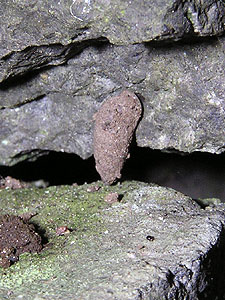 Lesser bulin snail (Merdigera obscura). Photo: Robert Nordsieck. |
The situation appears quite different in the banded snails (Cepaea hortensis and nemoralis), which are polymorphic and occur in many colours and patterns. Their shells may be yellow, brown, or pink, and show none, one, or several spiral bands – so conspicuous that almost everyone has seen them.
The advantage of this polymorphism, however, is that in any given habitat a proportion of the population is well camouflaged against the prevailing ground and vegetation cover. These individuals are less likely to be detected and eaten by their main predators, visually hunting songbirds such as the song thrush (Turdus philomelos). The abundance of banded snails in Europe testifies to the success of this strategy.
A similar strategy seems to underlie the bright polymorphism of the Cuban tree snails (Polymita picta). Their main predators are also visually hunting birds – in this case raptors, such as the snail kite (Rostrhamus).
![]() Banded Snails.
Banded Snails.
![]() Cuban Tree Snails (Polymita picta).
Cuban Tree Snails (Polymita picta).
 Yellow-grey shell slug (Testacella haliotidea): Auckland, New Zealand.. |
 Photos: Joseph Knight (iNaturalist). |
![]() Vitrinisation: Shell reduction in terrestrial
snails.
Vitrinisation: Shell reduction in terrestrial
snails.
Snails that live primarily in the soil, as well as some predatory forms, have reduced their characteristic shells in favour of greater mobility. Within the Vitrinidae, for example, one finds almost all transitional stages: from genera such as Oligolimax, which still have a complete shell, to Semilimax, in which the small shell is almost entirely overgrown by the mantle.
There are also two native groups of predatory semi-slugs: the Testacellidae ("backpack snails" or shell slugs) and the Daudebardiinae, a subfamily of the glossy snails (Oxychilidae). Both still possess a shell, but it has been reduced to a rudimentary plate carried on the back at the tail end of the foot. Both groups live mainly underground and prey primarily on earthworms.
 Common or Spanish roundback slug (Arion vulgaris). Photo: Robert Nordsieck. |
The largest European land snail is in fact a slug: the great black slug (Limax cinereoniger), which can grow up to 20 cm and in exceptional cases even reach 30 cm. Limacids and arionids can be distinguished externally: limacids generally have a more slender build and show a distinct keel on the rear third of the back. Anatomical examination reveals further differences: limacids retain a rudimentary internal shell plate beneath the mantle shield, which is completely absent in arionids.
 Hermann Löns observing a slug. |
The most important protection is their mucus layer. As already mentioned,
snail mucus is hygroscopic. In most slugs, the mucus is much more viscous than
in many shelled species. The slime of many arionids also tastes extremely
unpleasant, as described by the poet and naturalist Hermann Löns (1866–1914), a
well known malacologist (![]() Malacology), in his 1911 story "Ein ekliges Tier" ("A disgusting animal").
The sticky slime makes it very difficult even for animals that normally feed on
snails – such as hedgehogs, toads, or grass snakes – to grasp and swallow a
slug.
Malacology), in his 1911 story "Ein ekliges Tier" ("A disgusting animal").
The sticky slime makes it very difficult even for animals that normally feed on
snails – such as hedgehogs, toads, or grass snakes – to grasp and swallow a
slug.
![]() Hermann Löns: "Ein
ekliges Tier" (1911) (in German).
Hermann Löns: "Ein
ekliges Tier" (1911) (in German).
Another adaptation is behavioural: slugs generally emerge only at night or during rain and spend the daytime hidden in suitable shelters. This greatly reduces the risk of evaporation, as well as the danger of predation – although, of course, many predators are also active at night.

 Bosnian door snails (Herilla bosniensis) in the Klausen gorge near Mödling, Lower Austria. Right: Palatal view. Photos: © Alexander Mrkvicka, Vienna. |
Nevertheless, collections of land snail shells are of great scientific importance, as they contribute to understanding the composition of habitats and ecosystems. Based on shell characteristics, and with the aid of an identification field guide (see Literature), even non-specialists can usually determine at least the approximate species of a snail.
In the field, identification keys, which allow simplified choices between certain features, can also be very helpful. Land snails can be distinguished, for example, by the colour, pattern, and shape of their shells.
However, there are many groups, such as the door snails (Clausiliidae), whose identification is more difficult for laymen due to their high species diversity and the often great similarity of the species. In addition, a more precise identification often requires an anatomical examination, for example of the genital apparatus, by a specialist.
![]() Shell characters for identification.
Shell characters for identification.
In German.
 With photos by Stefan Haller: http://www.schneckenfoto.ch. |
Latest Change: 26.09.2025 (Robert Nordsieck).